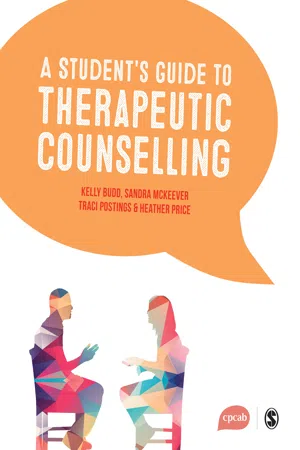
eBook - ePub
A Student′s Guide to Therapeutic Counselling
- 320 pages
- English
- ePUB (mobile friendly)
- Available on iOS & Android
eBook - ePub
A Student′s Guide to Therapeutic Counselling
About this book
Co-published with the CPCAB, this highly practical book is a comprehensive training guide based around the 7 areas that students have to evidence in order to become accredited. It offers a firm foundation of knowledge and skills, looks at practice issues, helps with study, and also answers the most common questions students have when training.
Frequently asked questions
Yes, you can cancel anytime from the Subscription tab in your account settings on the Perlego website. Your subscription will stay active until the end of your current billing period. Learn how to cancel your subscription.
At the moment all of our mobile-responsive ePub books are available to download via the app. Most of our PDFs are also available to download and we're working on making the final remaining ones downloadable now. Learn more here.
Perlego offers two plans: Essential and Complete
- Essential is ideal for learners and professionals who enjoy exploring a wide range of subjects. Access the Essential Library with 800,000+ trusted titles and best-sellers across business, personal growth, and the humanities. Includes unlimited reading time and Standard Read Aloud voice.
- Complete: Perfect for advanced learners and researchers needing full, unrestricted access. Unlock 1.4M+ books across hundreds of subjects, including academic and specialized titles. The Complete Plan also includes advanced features like Premium Read Aloud and Research Assistant.
We are an online textbook subscription service, where you can get access to an entire online library for less than the price of a single book per month. With over 1 million books across 1000+ topics, we’ve got you covered! Learn more here.
Look out for the read-aloud symbol on your next book to see if you can listen to it. The read-aloud tool reads text aloud for you, highlighting the text as it is being read. You can pause it, speed it up and slow it down. Learn more here.
Yes! You can use the Perlego app on both iOS or Android devices to read anytime, anywhere — even offline. Perfect for commutes or when you’re on the go.
Please note we cannot support devices running on iOS 13 and Android 7 or earlier. Learn more about using the app.
Please note we cannot support devices running on iOS 13 and Android 7 or earlier. Learn more about using the app.
Yes, you can access A Student′s Guide to Therapeutic Counselling by Kelly Budd,Sandra McKeever,Traci Postings,Heather Price in PDF and/or ePUB format, as well as other popular books in Psychology & Psychotherapy. We have over one million books available in our catalogue for you to explore.
Information
Part I Training To Be A Counsellor
1 Working Ethically and Safely as a Counselling Professional
This chapter is about working ethically and safely with clients as a counselling professional.
Ethical Frameworks


Reflection

So take a moment to think about working with clients – that’s quite a responsibility isn’t it? Just jot down anything that concerns you about working professionally, safely and ethically.
So I expect you have listed things like not letting my clients down, keeping their confidentiality, holding the boundaries, doing the right thing, not harming the client, being competent, managing suicide threats, making referrals, getting on with other people at the agency, using supervision.
Let’s start with what you know already. You have learnt that there are such things as Ethical Frameworks and that they exist to protect the client and counsellor, to ensure that the counsellor is accountable to a professional body and that the client has access to an avenue for making a complaint if necessary.
OK, so far? We’ll come back to some of these things later, but at this stage of your training it is about learning to apply and extend the skills and knowledge you already have in order to work with clients, within an ethical framework. This is the next step on from just carrying out practice sessions with your peers in class.


Exercise

Jot down as many words as you can think of that define ‘ethical’ for you.
Here are some of the more common ones – equitable, honourable, just, morally right, accepted standard of conduct, right minded.


Reflection

Consider the following: It may be scientifically possible to clone human beings, but is it ethical?




Activity
Find out which Ethical Framework is adhered to at your agency placement. Does it differ from the framework you have already signed up to? Print out a copy and familiarise yourself with all its m...
Table of contents
- Cover
- Half Title
- Acknowledgements
- Title Page
- Copyright Page
- Acknowledgements
- Contents
- About the Authors
- Introduction
- Part I Training To Be A Counsellor
- 1 Working Ethically and Safely as a Counselling Professional
- 2 The Therapeutic Relationship
- 3 Working with Client Diversity in Counselling Work
- 4 A User-Centred Approach
- 5 Working with Self-Awareness
- 6 Counselling Skills and Theory
- 7 Working Self-Reflectively
- Part II Practice Issues
- 8 The Counselling Training Placement
- 9 Placement Supervision
- 10 Agency Requirements
- 11 Personal Therapy Requirements
- 12 Trainee Self-Care and Avoidance of Burnout
- 13 Writing a Case Study
- 14 Recording a Counselling Session and Analysing a Transcript
- Part III Professional Issues
- 15 What If?
- 16 What Next?
- References
- Index